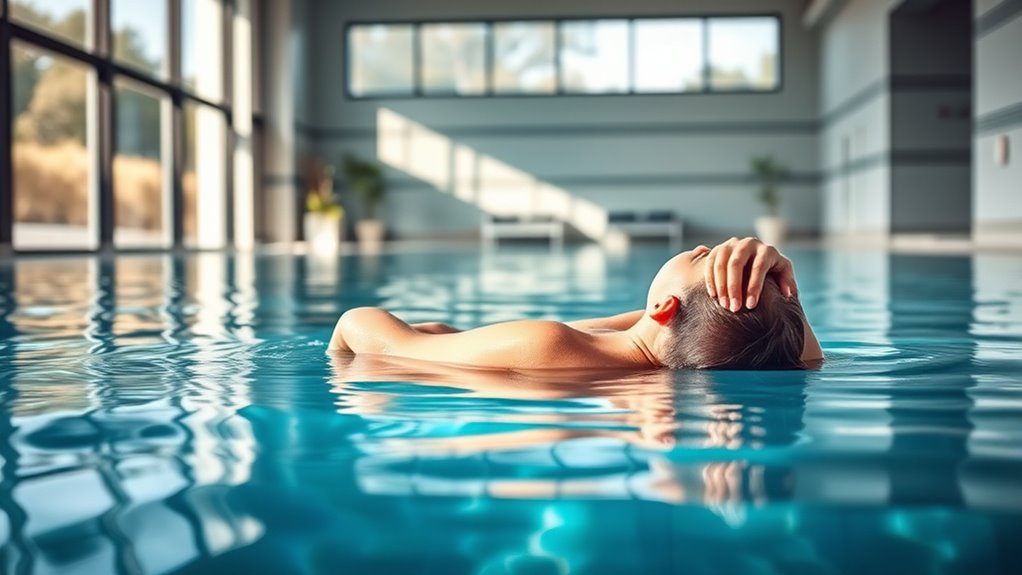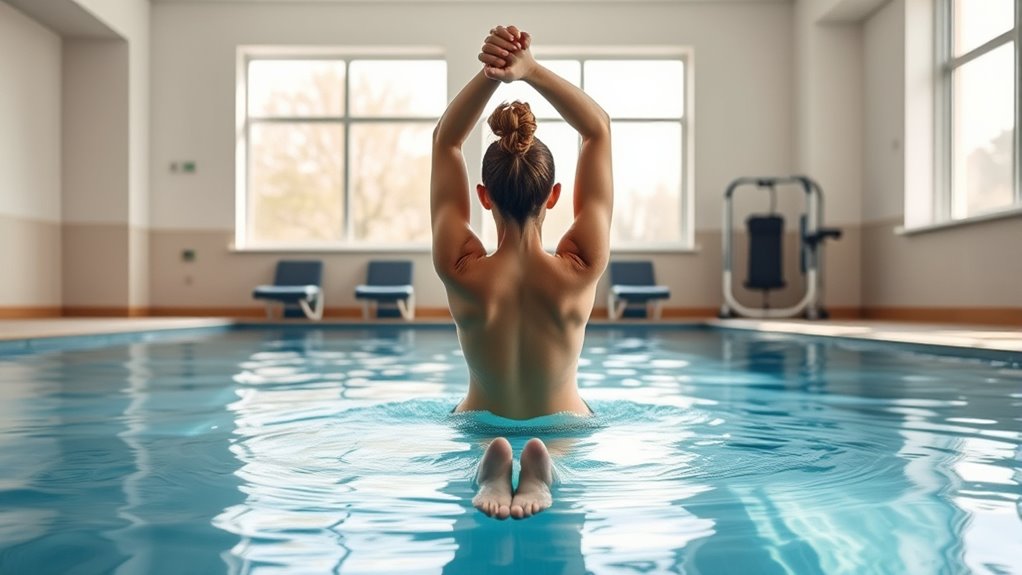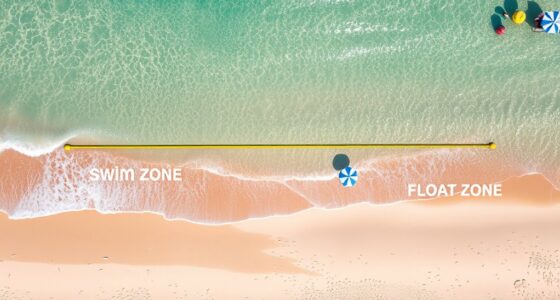To use floating for rehab and low-impact exercise, start by immersing yourself in water with gentle support or flotation devices to reduce joint stress. Focus on slow, controlled movements like water walking, gentle stretches, or resistance exercises to build strength and improve mobility safely. Incorporate breathing techniques to enhance relaxation. As you continue, discover how specialized techniques and equipment can maximize your progress and well-being during water therapy.
Key Takeaways
- Begin with gentle floating exercises to support joint stability and reduce impact stress during rehab.
- Incorporate water walking and resistance movements to strengthen muscles safely and improve mobility.
- Use buoyancy aids or floatation devices to maintain proper posture and enhance confidence in the water.
- Focus on controlled breathing and slow movements to promote relaxation and effective rehabilitation.
- Gradually increase exercise complexity and duration to build endurance while minimizing strain.

Have you ever considered how floating can enhance your rehab and low-impact workouts? If not, it’s time to explore the benefits of water therapy and aquatic fitness. Floating in water offers a gentle, supportive environment that reduces stress on your joints and muscles, making it ideal for recovery and gentle exercise. Unlike traditional land workouts, water provides natural resistance, which allows you to build strength without overexertion. This makes floating an excellent tool for those recovering from injury, managing chronic pain, or simply seeking a low-impact way to stay active.
When you incorporate floating into your routine, you take advantage of water’s buoyancy, which supports your body and minimizes impact. This support helps you move more freely and confidently, especially if you’re dealing with limited mobility or joint issues. Water therapy sessions often involve floating exercises that focus on improving flexibility, balance, and muscle activation. These exercises are designed to promote circulation, reduce swelling, and accelerate healing, all while being easy on your body. As you float, you can perform gentle stretches and movements that would be difficult on land, helping to restore mobility and reduce stiffness.
Aquatic fitness, combined with floating techniques, allows you to engage different muscle groups without the strain of gravity. You can perform water walking, gentle kicks, or resistance exercises while floating, which strengthens muscles and improves endurance. The water’s natural resistance challenges your muscles in a safe way, helping you build strength gradually. Because floating reduces the weight bearing load, you can focus on proper form and controlled movements, which is especially beneficial during rehab. Whether you’re working on recovering from surgery or managing arthritis, floating makes exercise more comfortable and sustainable.
Using floating for rehab and low-impact exercise also encourages relaxation and stress relief. The sensation of weightlessness can ease tension and help you focus on breathing, which enhances overall well-being. Many aquatic fitness programs incorporate floating techniques to create a calming environment that promotes mental and physical healing. Plus, the soothing properties of water can help reduce pain levels and improve your mood. Additionally, modern water therapy equipment often includes noise reduction technology, ensuring a peaceful experience that fosters relaxation and concentration.
Frequently Asked Questions
Can Floating Help Improve Balance and Coordination?
Floating in water can definitely help improve your balance and coordination. The hydrotherapy benefits, like reduced joint stress and resistance, make aquatic balance training effective for stabilizing muscles. As you practice floating, you engage core and stabilizer muscles, enhancing coordination. The buoyancy challenge forces you to adjust, boosting your overall stability. This low-impact exercise is gentle yet effective for refining your balance skills while supporting your rehab or fitness goals.
Is Floating Suitable for Elderly Rehabilitation?
Floating is highly suitable for elderly rehabilitation as it enhances elderly mobility and offers a gentle, low-impact form of aquatic therapy. You can enjoy reduced joint stress while improving strength, balance, and coordination. This supportive environment helps seniors regain confidence and independence safely. With proper supervision, floating becomes a valuable tool for maintaining overall health, making it an effective option for elderly individuals seeking rehabilitative and low-impact exercise alternatives.
What Are the Safety Precautions for Beginners?
You should start slow and always stay within your comfort zone. Use water resistance to gently build strength, but don’t push too hard too soon. Buoyancy benefits help reduce joint stress, so listen to your body and avoid overexertion. Always have a trained instructor nearby, wear appropriate gear, and make certain the water environment is safe and clean. These precautions help you enjoy floating safely and effectively.
How Often Should I Practice Floating Exercises?
You should practice floating exercises 3 to 4 times a week to fully enjoy the hydrotherapy benefits and make the most of aquatic therapy. While it might seem like a gentle activity, consistent practice boosts your recovery, reduces joint strain, and builds strength. Balance your sessions with rest days to avoid fatigue. Regular floating creates a calming, effective way to enhance mobility and overall wellness through low-impact exercise.
Can Floating Therapy Replace Traditional Rehab Methods?
Floating therapy can’t fully replace traditional rehab methods because water buoyancy and sensory deprivation target specific recovery needs. It’s excellent for relaxation, reducing pain, and improving mobility, but it lacks the targeted, controlled exercises often necessary in rehab. You should see it as a complementary treatment that enhances your recovery process, rather than a complete substitute for conventional therapies. Always consult your healthcare provider to integrate floating therapy appropriately.
Conclusion
Embracing floating is like opening a secret garden where your body can heal gently and flourish. With each buoyant movement, you’re sailing smoothly through recovery and low-impact workouts, leaving stress behind like driftwood. So, take the plunge and let the water cradle your journey to strength. Remember, in this fluid world, progress flows effortlessly—just relax, breathe, and ride the waves of your rehab adventure. Your body’s comeback is waiting to be written in the ripples.









